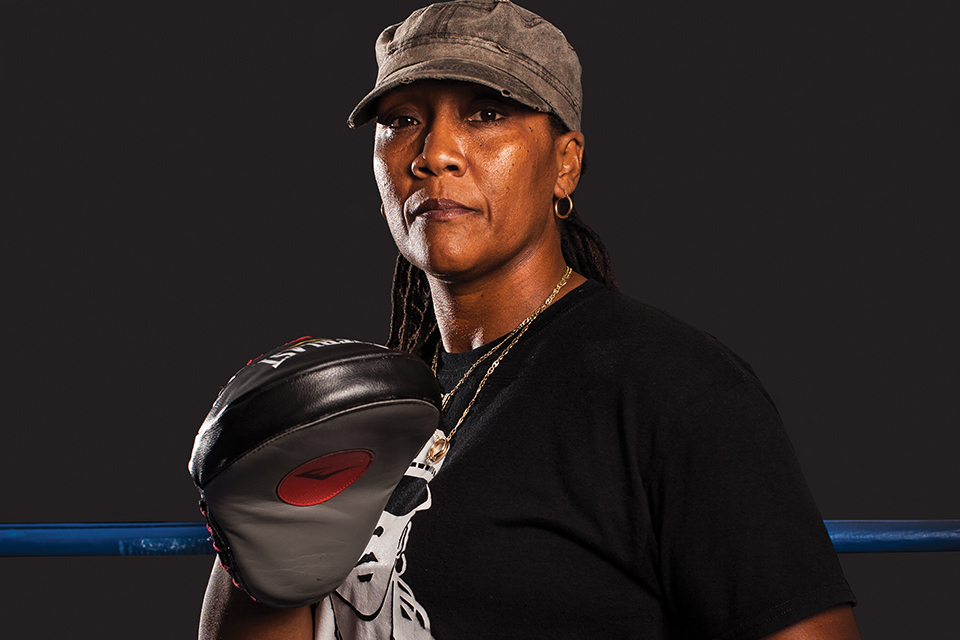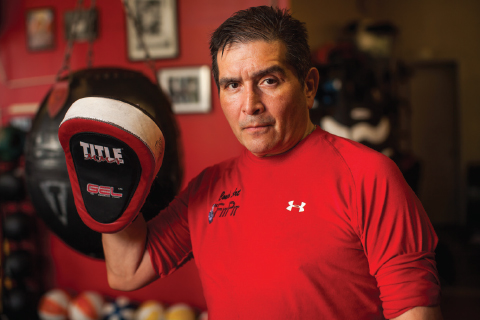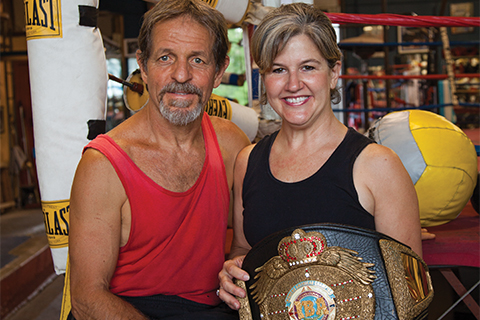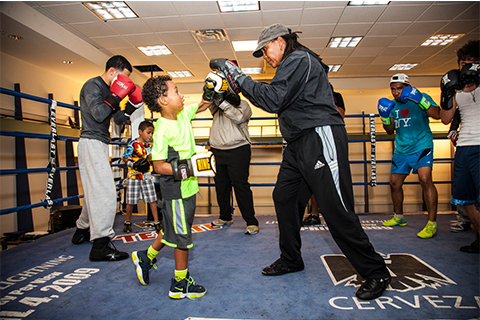Inside the Ring — Austin Boxing Gyms Keep Kids Safe and Communities Fit

As for the hub of boxing in Texas, that distinction probably goes to San Antonio. Even Dallas, Houston, and Corpus Christi are regarded for the number of boxing events they host and champions produced. But Austin stands out, too, as a healthy community of fighters, trainers, and people who box purely for fitness or for love of the sport—a big, warm, and, at times, contentious fight family.
Austin has dozens of gyms that provide some form of boxing training, like cardio kickboxing or self-defense training that includes boxing components and MMA training. For pure, old-school boxing, three gyms and their owners stand out as leaders: Fit Pit, Lord’s Gym, and Ann Wolfe Boxing and Fitness.
Walk into any one of these gyms any time of day, and there are people training on bags, shadow boxing in mirrors, hitting mitts with a coach, or sparring in the ring. The common denominator of success for each establishment is the welcoming atmosphere. These coaches have constructed communities of boxers who are engaged and training to fight. They range in age from 4 to 80, male and female, pros and future-pros-in-training. Kids training on scholarships and mid-career professionals are intermingled.
In Austin especially, the fight business exists not only to train fighters, but to be a place of refuge—from trouble at home, school, or work. Inside that safe place, boxers work hard and sometimes come away in tears, but the ring is where they go to build themselves up, to discover who they really are.
Members of these gyms refer to themselves, proudly and sometimes even reverently, as a “fight family.”

Fit Pit, Art Cardenas
Art Cardenas, retired Travis County Sheriff’s Office captain and former boxer, organizes some of the largest amateur events in town. Cardenas combines his natural warmth with a head tilt and eye-roll that reveals a man who spent 27 years in uniform and at least 20 years as a boxing coach.
He has seen all of the nonsense, so when he smiles and tells you, gently but firmly, to move, you will move.
The Fit Pit opened in 2010, but Cardenas has been part of Austin’s boxing scene for decades, first as an amateur boxer when he was a kid and then as a coach while he was also serving in the sheriff’s office. The gym has the feel of a place with history, probably in part because Cardenas has deep respect for Austin’s fighting roots. He made sure to mention the influence of Richard Lord, who has been running boxing gyms in town since the 1970s, and the A.B. Cantu Pan Am Recreation Center, which he said was important for establishing boxing in Austin in the 1940s and 1950s and still has an active boxing club for youth.
Cardenas even has part of Austin’s boxing history working at his gym in Joe Vela, who has been training boxers for 65 years and who used to operate Austin Boxing Against Drugs. (A common focus of the boxing coaches is providing something healthy for kids to do, to keep them away from crime and drugs.) Vela, a former amateur champion, arrives at the gym with a jaunty driving cap and a sweet smile and has plenty of advice for short fighters who are forever facing towering opponents.
Cardenas brought the Golden Gloves back to Austin five years ago, after the franchise was lost in the 1980s. The Golden Gloves is a showcase for local amateur boxers, and the winners in each weight class can go on to regional, state, and national competitions—even potentially qualifying for the Olympic boxing team. Some Golden Gloves champs move to pro fighting. Cardenas worked for two years to get the right paperwork and permissions to bring the Golden Gloves back to the capital.
“I thought it was important,” Cardenas said. “It’s successful, good crowds, good community-building for the youth—a lot of pride goes into representing your gym. It gives our youth an opportunity to show their athleticism, commitment, heart.”
Cardenas and his coaches also trained most of this year’s Battle of the Badges contenders. That event pits police officers against firefighters in charity bouts, and this year, it was huge—16 fights, some with fighters who had no previous boxing experience and some with fighters who’d seen the inside of a ring before.
Regardless of why a boxer is at the Fit Pit, each gets essentially the same workout—though those training for a fight get more of it and definitely spar more often. Some people who come in looking for a good workout “just want to hit mitts,” Cardenas said. “I don’t let them do that. You also need to learn how to shadow box, use the ring, hit the bags properly, know how to use speed bags, double end bags, jump rope. It’s a nonstop workout. I’m training you how to fight, and you get in shape doing it.”
Even if you’re not training for a fight, if Cardenas deems you ready and you meet the qualifications, you can get in the ring on sparring nights and see what you’re made of.

Lord's Gym, Richard Lord
Richard Lord has been running boxing gyms in Austin since the mid-1970s, though he didn’t open the one that bears his name until 1981. Lord, whose father was a boxer, has been fighting since he was old enough to walk. He was 5 years old when he entered his first organized fight, and some of the trophies scattered around his office indicate that he won in the 36-pounder and 38-pounder divisions.
Lord answers his gym phone with “Hello, boxing.” He’s friendly and opinionated, and he knows how to train both career-minded and fitness-minded boxers. His secret? Conditioning.
Lord takes some of his fighters for a run up and down the ramps at the UT stadium every Sunday morning—pulling them through a workout that ends up being 6 miles worth of running in an hour. He also puts people through the typical conditioning workouts.
“Pull tires, jump rope, medicine ball workouts, agility drills, pull-ups, sit-ups, lots of core work. Basic stuff. Just excessive amounts, I guess,” Lord said.
Lord came to Austin to major in psychology at UT, then opened a boxing gym and a pizza place, became a professional boxer, and never left. “I use that psychology degree every day in the gym,” he said with a smile.
Some world-class boxers have come through Lord’s Gym, including Jesús Chávez—a beneficiary of Lord’s conditioning-focused approach. “He came in at 175 pounds, smoking two packs of cigarettes a day,” Lord said. “He did his first title fight at 125. Chavez listened. He lived it. Ate, drank, and slept boxing every day, all day long. Within two years, he was No. 1 in the world.”
Lord also helped lead the way for women’s boxing in Texas. In 1993, two women from his gym fought in the first-ever professional women’s boxing match in Texas. Those women were Lori Lazarine (now Lord’s wife, Lori Lord) and Amy Miller (known now as Amy Simmons, creator of Amy’s Ice Cream). Lori went on to a pro boxing career and now works as a trainer at the gym.
Lord welcomes all who want to train, no matter their goals. Though he does produce champions, most of his clients are just regular people, from kids to retirees, who like boxing. Some clients have been with him since 1983—they’re in their 70s now and still getting in the ring to spar.
If you go to Richard Lord wanting to make it as a pro boxer, he will test you over and over. “I’m a lot more casual for the others who don’t want to go pro,” he said. “We still work out hard. The basic stuff is very hard. I make it available to them to take it wherever they want to. Some people come in and don’t want to ever spar. And that’s fine—it doesn’t matter. Come in and box. It’s a fun sport.”

Ann Wolfe, Ann Wolfe Boxing & Fitness
Ann Wolfe has the type of life story that ends up in movies. As a young single mother, she was in an Austin emergency room when she saw women’s boxing on TV and decided to try it. Turned out, she was pretty good.
Wolfe is an eight-time world champion pro boxer and the first fighter ever (male or female) to hold four titles in four weight classes at the same time. Wolfe opened her gym in Austin about 15 years ago, and recently it was declared a nonprofit organization, Get Off the Ropes.
Get Off the Ropes’ main goal is “to get kids through high school without a felony or a pregnancy.” Like the other coaches profiled in this article, Wolfe believes that boxing can save lives. “Most people think boxing is just violent and aggressive,” she said. “But the majority of kids I work with come up in violent situations. They are bullied, or they are the bullies. Either way, boxing attracts them. It’s something they can touch.”
And like Richard Lord, Wolfe uses psychology while she coaches. “With both the bullies and the kids being bullied, it’s all fear. Once they know that they can protect themselves, the bullies don’t feel the need to prove anything,” Wolfe said. “They all carry a different kind of confidence with them. You can’t hide in the ring. If you know you’re strong, insults don’t matter. You don’t have to respond to them.”
Though Wolfe sees her mission as helping kids, she sincerely loves boxing and she loves to share it with anyone who wants to learn. In fact, she welcomes people who just come in for fitness partly because she thinks they and the kids have a lot to offer each other. Wolfe believes that the shared love of boxing brings together people and communities for the better of all.
“I want teachers and doctors and lawyers and anyone who loves boxing to come in. I mix them in with the kids. It’s the only way these kids will ever come into contact with professionals like that,” Wolfe said. “I want the kid from Del Valle with a mom on crack to see how other people live, and I want those professionals to see what happens to the kids.”
If you are one of the majority of Wolfe’s clients—the fitness-focused boxer—your monthly donation to Get Off the Ropes is tax-deductible, and you get boxing in return. The kids in need who go to Wolfe’s gym “pay” their way by doing community service; she requires them to show proof of at least two hours a week of service at local organizations.
Wolfe’s coaching is rough, both physically and emotionally. At 43, she is as fit as the younger pro boxers she coaches, and she will work out with them and force them to go as long as she does. “I don’t try to make the fighter. I try to make the man or the woman,” Wolfe said. “I’m known as having some of the most brutal training on earth. It will bring out your character. Once you come through my program, you understand the battle, you’re in combat.”
For clients focused on fitness, Wolfe will ask about their goals and, as she says, “I’ll get brutal, then, too. I’ll keep asking if you think you’re able to do it. I’ll make you face it, make you find a goal you can reach. I’m not in it to break people, but I keep it real. I want them to have the confidence they need to be on the path.”
Wolfe puts on fights several times a year to showcase her boxers’ talents. Any money the shows make goes directly back into the nonprofit.
Bottom Line
All of these gyms have a community focus, providing a place for kids and teens to learn discipline and fitness and supporting local charities with most of their events. These aren’t the only coaches who offer good boxing in Austin—but they are some who have been around the longest and provide opportunities for amateur fighters. Plenty of gyms exist with excellent coaches and amazing communities. Take the advice of these coaches, and find one that works for you.
For those adults reading this, it’s probably too late to make a career in the ring. Boxing champs are raised—they start in their early teens or even younger. But that doesn’t rule out boxing for sport. Adults or children who are interested in starting out should visit these gyms, find a coach, and ask to be put to work. A boxing gym can provide a great workout and, if nothing else, the opportunity to find improved fitness. “I’ve got probably half a dozen therapists—physical and mental health therapists—that send their clients in here for therapy,” said Lord. But beyond those fitness benefits come a sense of belonging. For those who work hard and pitch in when needed, a diverse and supportive fight family waits to welcome them into the fold.
What to Look for in a Boxing Gym
The coaches at these gyms work with people hoping to go pro and people who just want an effective, exciting workout. Each coach has strong feelings about what to look for in a good boxing gym:
Art Cardenas of the Fit Pit:
Research the gym to make sure they’re registered with USA Boxing—that protects you if you get injured, because they have insurance. Good trainers should have ring experience, study the sport continuously because it’s ever-evolving, and be honest with their students. They should know what it feels like to be hit and be a good cornerman—be able to wrap hands and close cuts.
fitpitaustin.com
Richard Lord of Lord’s Gym:
Find a coach that practices what they preach, in working out and in eating. It’s hard to take advice from someone who’s not in shape. Find a gym that’s a real boxing gym and not a pseudo boxing gym. You’ve got to just come in and feel it. If it’s air conditioned, that’s a red sign, maybe. I’ve been very staunch about having natural air. You get in better shape if you work in the elements, whatever they are.
lordsboxing.com
Ann Wolfe of Ann Wolfe Boxing and Fitness:
Figure out for yourself what your goal is. Don’t be intimidated if you want to box; most people in most gyms are not pro boxers. Just go and try it, look to see if the gym has what you want.
getofftheropes.com






